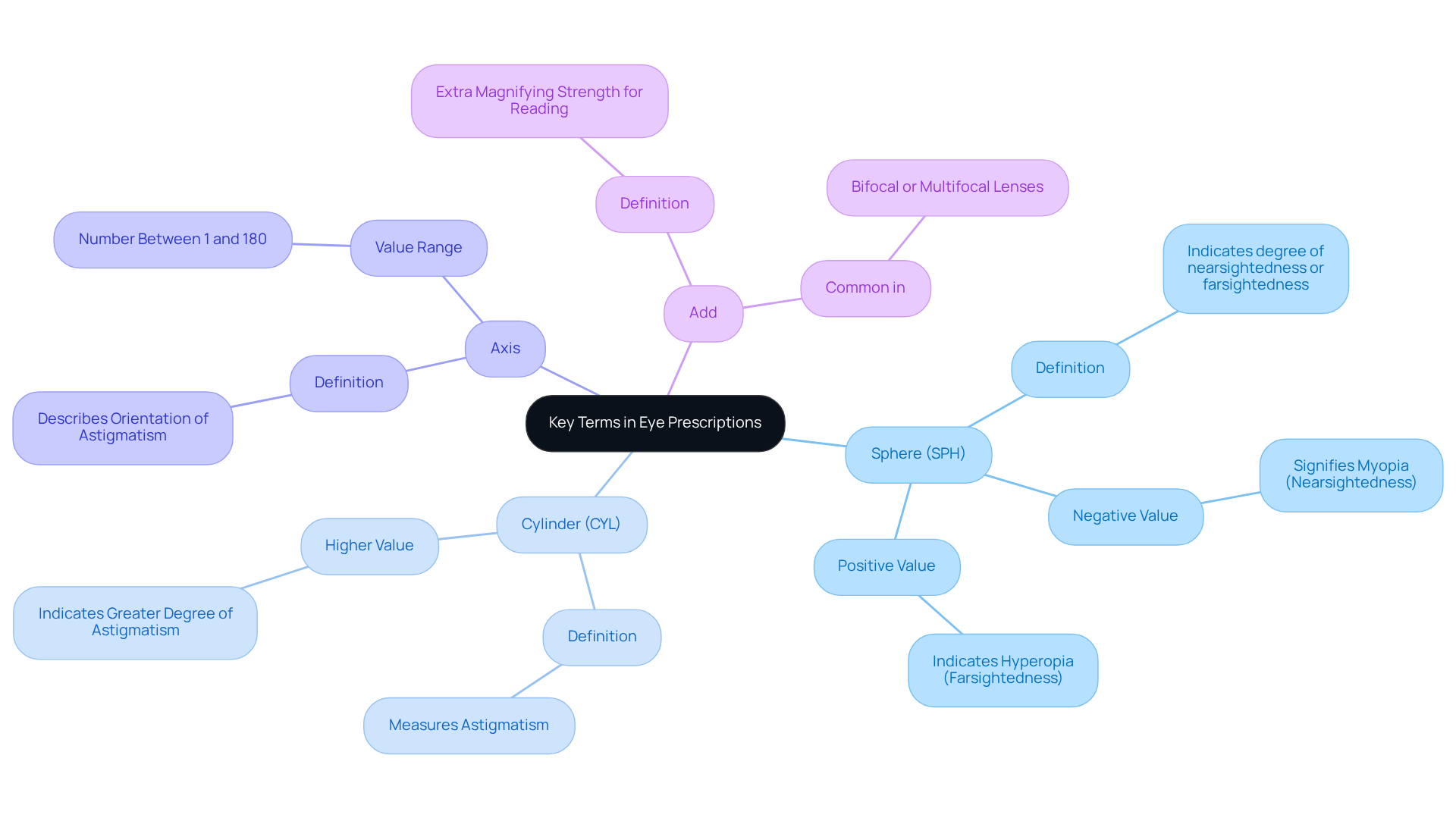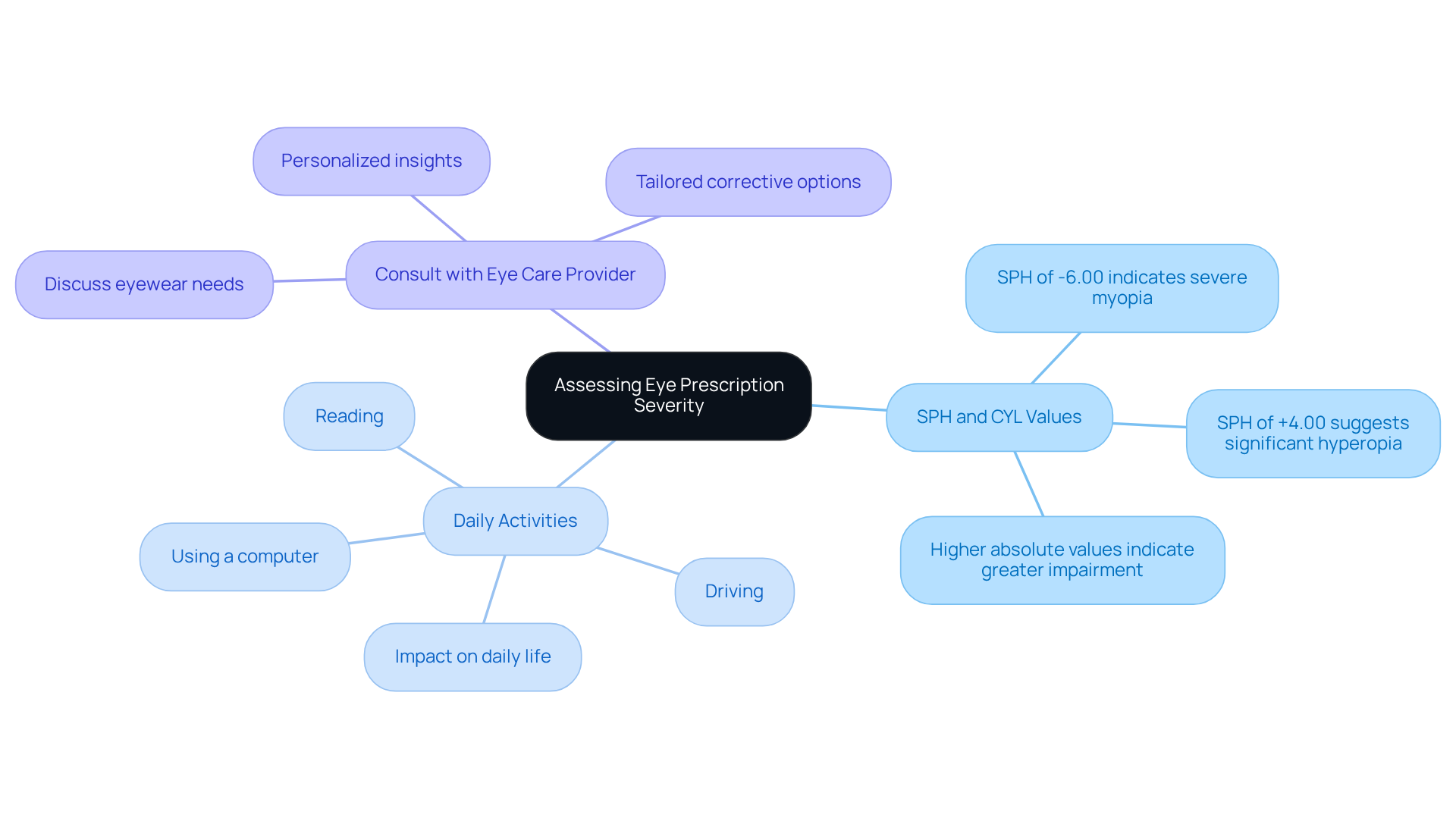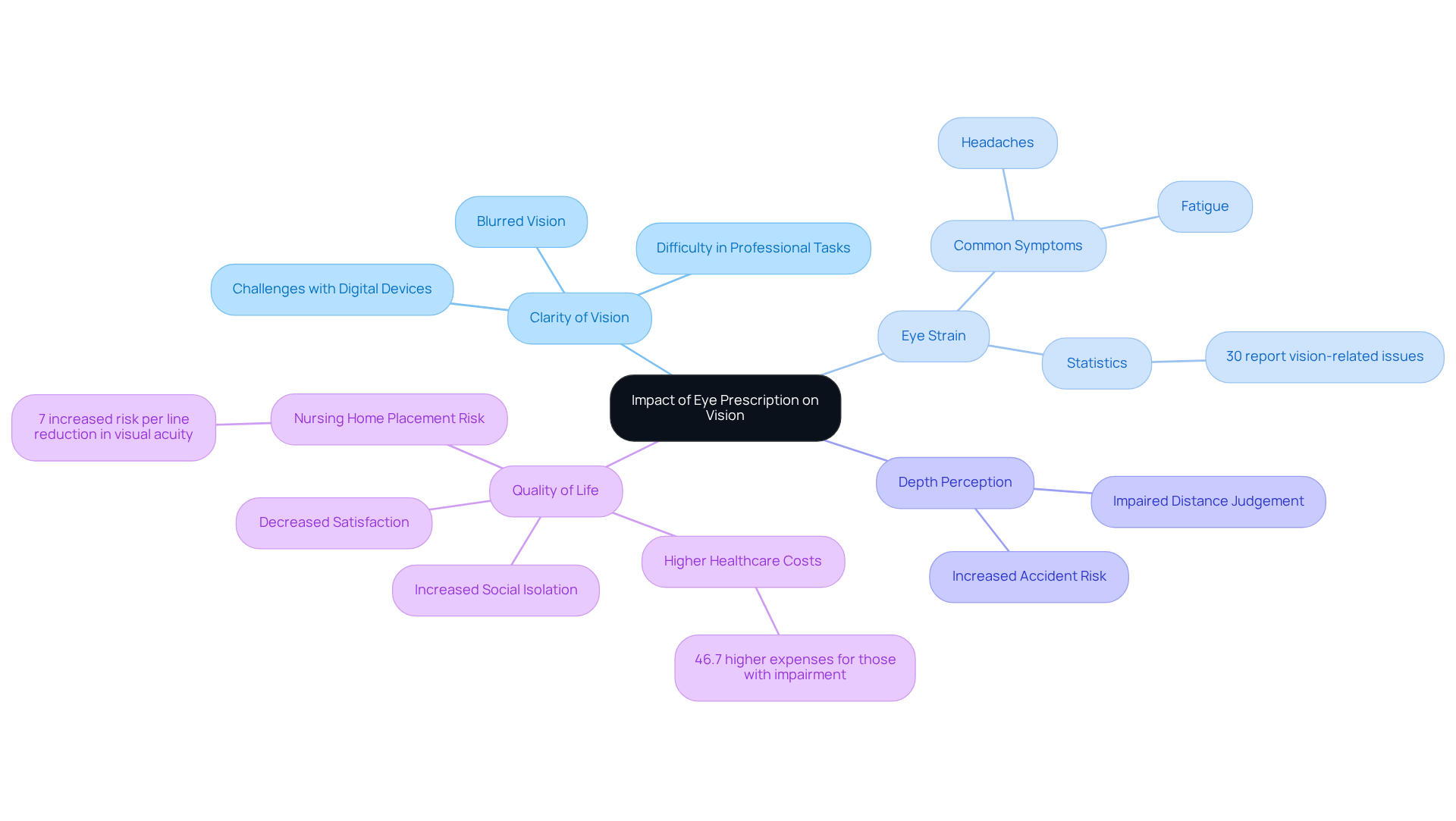Posted by: Northwest Eye in General on October 5, 2025
Overview
The severity of your eye prescription can deeply affect your vision, influencing clarity and potentially leading to eye strain. We understand that this can diminish your overall quality of life. Higher SPH and CYL values indicate greater vision impairment, which may result in challenges during daily activities and increase the risk of accidents. This highlights the importance of seeking corrective measures and ensuring regular eye examinations. We are here to help you through this process, reinforcing the need for care and support.
Introduction
Understanding the nuances of an eye prescription can often feel like deciphering a foreign language. We understand that this can be overwhelming, yet it holds the key to unlocking clearer vision and better eye health. By grasping essential terms like sphere, cylinder, and axis, you can gain valuable insights into your visual needs and the severity of your prescription. It’s common to wonder: how does one truly assess the impact of their eye prescription on daily life?
This article delves into the intricacies of eye prescriptions, exploring their implications on vision clarity, eye strain, and overall quality of life. We are here to help you navigate these complexities, empowering you to take proactive steps towards improved visual well-being.
Understand Key Terms in Eye Prescriptions
To help you better understand your eye prescription, we want to familiarize you with some key terms that are important for your vision care:
- Sphere (SPH): This indicates the degree of nearsightedness or farsightedness. A negative value signifies myopia (nearsightedness), while a positive value indicates hyperopia (farsightedness).
- Cylinder (CYL): This measures astigmatism, which can be caused by an irregularly shaped cornea. A higher cylinder value indicates a greater degree of astigmatism.
- Axis: This is a number between 1 and 180 that describes the orientation of astigmatism. It is only relevant if there is a cylinder value present.
- Add: This refers to an extra magnifying strength for reading, commonly found in bifocal or multifocal lenses.
Understanding these terms is essential. Grasping them will empower you to discuss your eye care needs knowledgeably with your provider. We are here to help you through this process, ensuring you feel confident and informed about your vision health.

Assess the Severity of Your Eye Prescription
To assess the severity of your eye prescription, we encourage you to consider the following:
-
Review Your SPH and CYL Values: We understand that the numbers on your prescription can feel overwhelming. However, how bad is my eye prescription may be reflected by the higher absolute values of SPH and CYL, indicating a more significant vision impairment. For instance, a SPH of -6.00 indicates severe myopia, while a SPH of +4.00 suggests significant hyperopia.
-
Consider Your Daily Activities: It’s common to feel uncertain about how your vision impacts your daily life. Reflect on how your eyesight affects tasks such as reading, driving, or using a computer. If you find these activities challenging, it may indicate how bad is my eye prescription and that your corrective measures need more attention than you realize.
-
Consult with Your Eye Care Provider: We recommend discussing your eyewear needs with your ophthalmologist or optometrist. They are here to provide personalized insights into how your prescription affects your vision and can suggest suitable corrective options tailored just for you.
By assessing these elements, you can gain a clearer understanding of how bad is my eye prescription and its seriousness regarding your sight. Remember, we are here to help you through this process.

Explore the Impact of Your Prescription on Vision
The impact of how bad is my eye prescription on vision can manifest in several significant ways.
-
Clarity of Vision: We understand that a higher prescription often correlates with blurred vision, leading to concerns about how bad my eye prescription is for seeing objects clearly at various distances. This can lead to difficulties in both professional and personal settings, affecting tasks such as reading or using digital devices.
-
Eye Strain: It’s common to feel the strain that comes with unadjusted lenses. Many individuals frequently experience eye strain, headaches, or fatigue, particularly after extended visual tasks. Studies indicate that nearly 30% of individuals with chronic conditions report vision-related issues, highlighting the prevalence of eye strain in the population. Optometrists stress that clarity of sight is essential for alleviating eye strain and improving overall comfort during visual activities, which can be greatly affected by how bad is my eye prescription.
-
Severe prescriptions can impair depth perception, leading to questions about how bad is my eye prescription, which complicates activities like driving or participating in sports. This impairment can increase the risk of accidents, as individuals may struggle to judge distances accurately. Notably, 49 percent of visually impaired hip fracture patients had untreated cataracts, underscoring the importance of addressing cataracts to prevent further complications.
-
Quality of Life: Impaired sight can significantly hinder daily activities, leading to a decreased quality of life. Individuals with sight impairment often express greater dissatisfaction with life and heightened risks of social isolation. Studies indicate that individuals with any impairment in sight incur 46.7% higher expenses compared to those without such impairment, emphasizing the need for corrective actions. Furthermore, each line of reduction in presenting visual clarity increases the risk of subsequent nursing home placement by 7%, highlighting the long-term consequences of inadequate sight. Corrective lenses or surgical options can dramatically enhance visual function and overall well-being, allowing individuals to engage more fully in their daily lives.
Understanding these effects emphasizes the significance of routine eye examinations to assess how bad is my eye prescription and take suitable corrective actions to preserve optimal eye health. By addressing eye strain and ensuring clarity of vision, we can help improve your daily experiences and overall quality of life.

Conclusion
Understanding the intricacies of an eye prescription is crucial for maintaining optimal vision health. We understand that navigating this information can be overwhelming, but familiarizing yourself with key terms such as sphere, cylinder, and axis can empower you to engage in meaningful discussions about your eye care needs. Recognizing the severity of your prescription not only sheds light on potential vision impairments but also equips you to seek the appropriate corrective measures.
This article highlights the importance of assessing the SPH and CYL values, considering your daily activities, and consulting with eye care professionals. These steps are essential in understanding how significant your eye prescription may be and its impact on clarity of vision, eye strain, and overall quality of life. The correlation between prescription strength and vision-related challenges underscores the necessity for routine eye examinations and timely corrective actions.
Ultimately, addressing your eye health is not merely about clarity of sight but also about enhancing your quality of life. We encourage you to take proactive steps to understand and manage your eye prescription, as this can lead to significant improvements in your daily activities and overall well-being. Engaging with eye care providers and prioritizing your vision health will ensure that you can navigate your life with confidence and clarity.
Frequently Asked Questions
What does “Sphere (SPH)” mean in an eye prescription?
Sphere (SPH) indicates the degree of nearsightedness or farsightedness in your vision. A negative value signifies myopia (nearsightedness), while a positive value indicates hyperopia (farsightedness).
What is the purpose of “Cylinder (CYL)” in an eye prescription?
Cylinder (CYL) measures astigmatism, which is often caused by an irregularly shaped cornea. A higher cylinder value indicates a greater degree of astigmatism.
What does the “Axis” refer to in an eye prescription?
The Axis is a number between 1 and 180 that describes the orientation of astigmatism. It is relevant only if there is a cylinder value present.
What does “Add” mean in the context of eye prescriptions?
Add refers to an extra magnifying strength for reading, commonly found in bifocal or multifocal lenses.
Why is it important to understand these key terms in eye prescriptions?
Understanding these terms is essential as it empowers you to discuss your eye care needs knowledgeably with your provider, ensuring you feel confident and informed about your vision health.






